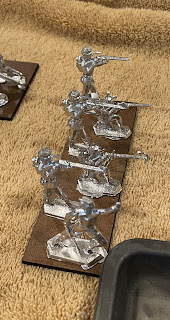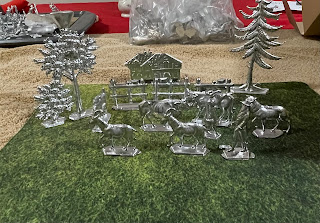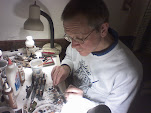Through a fortuitous alignment in work and holiday schedules I was able to get five days off at the cost of one vacation day last week. Unfortunately for my plan of doing a couple of long bike rides, we were under a “heat dome” with record-setting temperatures, making that inadvisable.
What I did instead was to set up the casting gear, as molds (unlike bicyclists) are benefited by extreme heat.
Since the last time I cast, I had acquired one of the remaining molds to make this project practical, by my rather whimsical standards, of course: a mold making a set of three Prussian/German artillerymen in the ~40mm scale.
I have two molds for cannon, a Schneider 74, and a WGW 5926. I have had little luck in getting a complete casting out of the Schneider mold, so I hoped that the hot day would do the trick.
As it was, I decided this was close enough and I would patch the missing spokes with greenstuff or hide them with some foliage.
I was a little surprised to pour a 95% complete (i.e. repairable) example of the WGW 5926 just as I was stopping for lunch one of the days.
I even managed to make some cavalry, although they will require some weapons repairs.
These are from Schneider molds 1 and 3, I believe.
The infantry was generally casting well, particularly the standing and kneeling firing pairs, although some marching Prussians turned out to be rather fussy.
With some figures cast in a previous experiment, three afternoons spent at this allowed me to cast enough figures for a French(ish) army and a Prussian(ish) army for One Hour Wargames, less one cavalry unit for each side. As can be seen in the basing mock-up picutres above, my plan is for each army to consist of 4 infantry units (each of 6 figures on 2 60x40mm bases), 2 skirmisher units (each of 4 figures on 2 60x60mm bases), 2 cavalry units (one only right now, consisting of 4 figures on 2 60x60mm bases), and 2 artillery units (each of a cannon and 3 crew on a 60x80mm base).
The Schneider mold series has a few “dramatic” figures. I don’t yet know what I’ll do with the “falling wounded” or “clubbing with rifle” poses, for example.
Schneider had an extensive range of molds. (A link to their catalog can be found
here.) I have some scenery molds, so while I was casting I decided to make a few more trees and try a sub-scale house mold I have.
As the fates will have it, the house proved remarkably easy to cast; I got three in three pours. The tree mold is also very reliable. I’m thinking for this project I’ll mount the trees on round bases and scatter a few over the cloth forest bases for appearance.
My elder son gifted me with a
grandchild last March, so we have been idly considering the proper age for involvement with our hobby. Before that time, though, perhaps the Schneider molds could be used to produce a more pacific play set:
This is an assortment of Schneider farm animals, farm people, trees, and one of the houses (off in the distance with forced perspective 😆). The fence section is one of the cavities in the mold with the cow and the farm woman. I also have a selection of Schneider zoo/wild animal molds. I’d like to give them a try next time. With the recent Not Quite Seven Years War games inspiring some work, I will probably need to haul out the gear sometime soon and fill out some partial units, so I don’t think it will too long before the next session.
























